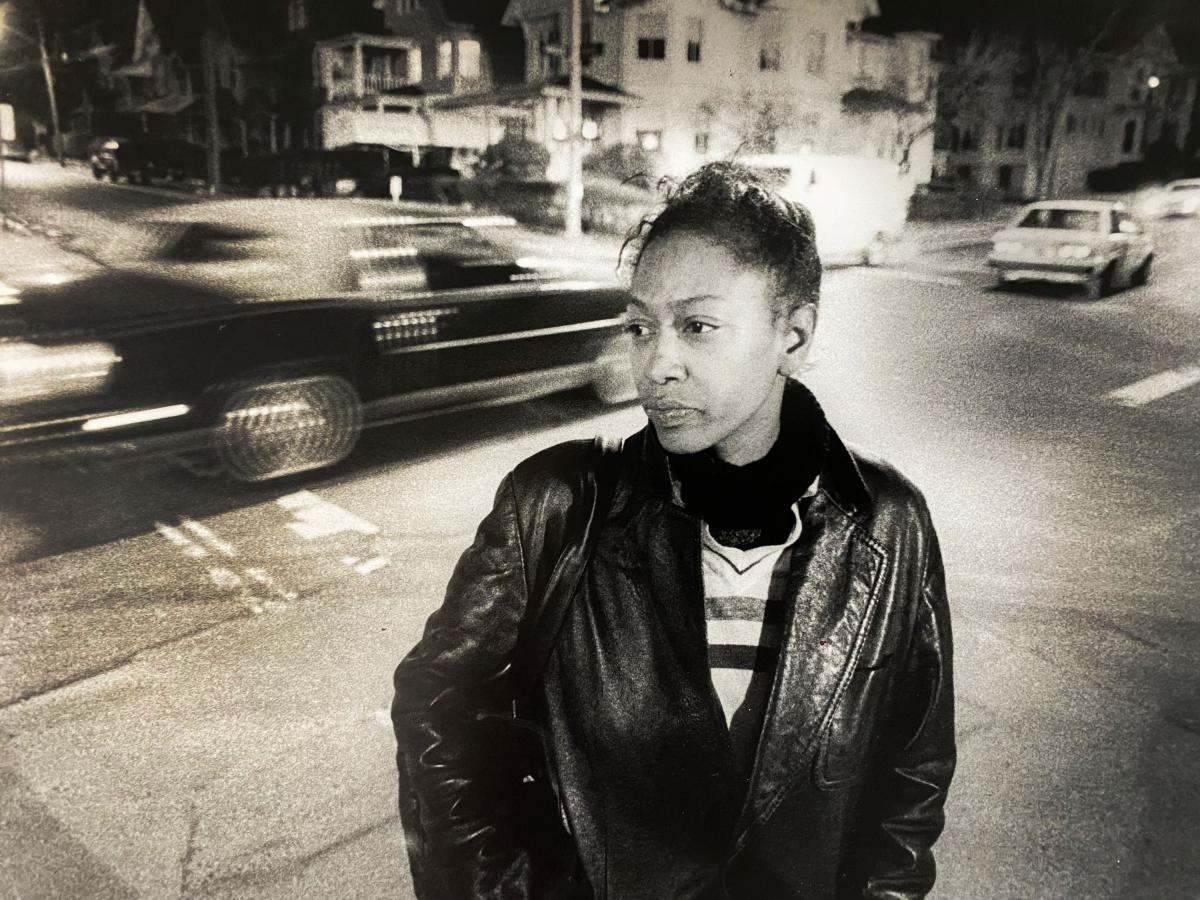Investigation Into Unsolved Murders

Since 1988 eight women have been killed along the Route 8 corridor north of Waterbury. Six remain unsolved, and a seventh is shrouded in unanswered questions. Clockwise from top left is Karen Everett, Mildred Alvarado, Frederica Spinola and Jessica Muskus.
Story By Robert Muldoon
In April 2020 I was in pandemic-lock down in my Boston apartment and surrounded by unopened boxes, some that had not been peeked into for decades. After my mother had died, we sold our family home of 50 years and I had a lot of boxes to rummage through.
Buried deep in one box was a folder I hadn’t touched since 1993, the year I left my career in journalism. Printed in faded ink on the tab was the word, “Waterbury”. I had no idea that I still had the files and notes from a huge story I had been working on when I left my job as police reporter at the Register-Citizen newspaper in Torrington, Connecticut. A sudden surge of memories hit—followed by pain, regret and shame that the story was never published.
I had to call John Murray (the Publisher of The Waterbury Observer) immediately. He’s the only one in the world who could possibly understand.
###
On January 6, 1993 a woman’s body was found off Valley Road in the Campville section of Harwinton. The following day the Connecticut State Police identified the body as Evelyn L. Bettancourt, 27, of Waterbury, who had been shot four times in the head.
Six weeks earlier, in November 1992, another woman had been found dead in Waterbury on Chase River Road. And in 1988 and 1989 two other women’s bodies had been found in the Campville section of Harwinton, on the Litchfield border, dumped along the east bank of the Naugatuck River.

Valley Road in Harwinton is snuggled along the Naugatuck River. It is isolated, and four women’s bodies have been dumped here.
The other two women found in Harwinton had been strangled. The woman found in Waterbury had been stabbed. All four had police records—including prostitution and drugs. All were from Waterbury.
Police were not “making any conclusions as to whether the cases were connected,” but termed them a “cluster of killings.” But rumors were afloat, confirmed by police, of suspicions of “a white man in a van.” Anyone with information was asked to call state police.
###
In 1993, John Murray and I worked for the Register-Citizen in Torrington: John, an award-winning photojournalist; me, a 33-year-old rookie reporter, just trying to hang on.
The story was John’s idea.
“These bodies keep showing up in our backyard,” he said, meaning Harwinton was in our paper’s coverage area. “We need to go on the streets where these women are being killed and see what’s going on.”
I was the new police reporter—just hired a few months before. I didn’t even have insurance yet. That came after 6 months. Yea right, I’ll head out to where a serial killer is on the loose without insurance. But John was persuasive.
“We need to go to Waterbury where the women are being picked up and murdered. Are they still on the streets with a killer on the loose? If so, why?”
Anxiety in the region was high. Evelyn had just been murdered. Mary Jo Markiewicz had been murdered just weeks before.
“Who is the ‘man in the van’?” John peppered the air with questions. “We need answers.”
So three days after Evelyn had been shot, six weeks after Mary Jo had been stabbed, John and I set out for Waterbury. Death hung heavy in the air.
###
We arrived at Willow and Grove Streets and found a shadowy underworld of women standing on sidewalks, while men in cars slowly circled the block—around and around. Some of the women beckoned openly, some rushed into the streets, others only made furtive eye contact.
A half-dozen women were working this way. Some knew Evelyn, killed just days earlier. Some knew Mary Jo. Some knew both. All had heard about “the white man in the van.” We talked to four—and three, out of caution, gave aliases: “Linda”, “Diana”, “Jackie.” Those three admitted to fear. But the fourth, in particular, stood out.
She gave her full name. She gave her age. She spoke openly about her 8-year-old daughter. She said she was Cape Verdean. She let us take a photo. Frederica Spinola (Rica for short) was fearless.

Frederica Spinola standing on Grove Street in downtown Waterbury in January 1993. Photograph by John Murray
John asked: “If I told you I was the killer, and offered you $20, would you go with me?”
Rica didn’t hesitate. “I’d go,” she said. “You don’t look like a killer.”
Rica wasn’t erring on the side of caution.
Below is the story, just as it was typed up then, in the long-lost folder, of the night of January 9th, 1993 when John and I plunged into Waterbury seeking answers.
###
They keep showing up in our backyard, three in four years, prostitutes from Waterbury, their bodies dumped in the woods off Valley Road in Harwinton.
Two were strangled: Karen Everett, 24, in October 1988 and Mildred Alvarado, in January 1989. A third died of gunshots to the head: Evelyn Bettencourt, known as “Lisa”, was found face up in the woods, 100 feet off Valley Road, in January 1993. Those were the ones in Harwinton.

The Campville section of Harwinton is a few hundred yards east off a remote exit on Route 8.
In November 1992, Mary Jo Markiewicz, 34, was found near the railroad tracks in Waterbury, stabbed in the neck and chest.
All were known prostitutes, police said. All had a history of drug abuse. No arrests have been made.
Who are these women who end up in our back yard, their lives snuffed out? Where do they come from? Why do they do what they do, even as the body count mounts?
Karen, Mildred, Evelyn and Mary Jo cannot tell their stories, silenced by hands, gun, and knife. It is for those left behind, who still walk those streets, the killing streets, to tell their own stories.
Here are the stories of “Linda”, Rica and “Diana.”
Linda
The stench of death still hung in the air. Three days before, Evelyn had been shot four times in the head. And yet Linda, 39, was out on the same streets, as she had been on and off for 10 years. But this night she was taking precautions.
“Are you the killer?” she asked the strange man, circling the block, over and over, up Willow Street, right onto Grove, right onto Holmes, eyeing her and the half dozen like her standing on the street.
Without waiting for an answer, she hopped in the car with out-of-state plates. Wearing jeans and a turtleneck, she had strawberry blonde hair, painted red lips and bloodshot eyes. She carried a razor in her pocket.
“If someone tried anything, I’d bite them so hard, then cut them,” she said, a feral rage bristling as she flashed the blade.
Linda needs $20 to buy a bag of p-dope, a synthetic heroin that can be injected or snorted. She is dope sick. She said she gets $30 for oral sex, $40 for regular sex, and $50 for a little of both. But everything is negotiable. In six hours, she has made $130.
“The only reason to sell your ass is for drugs,” she said. “Every girl out here walks for drugs. They might say it’s for milk and bread, but the reality is drugs.”
Linda knew Evelyn Bettencourt. She did time in Niantic Prison with Mary Jo Markiewicz. They rode the bus home to Waterbury from Niantic on November 18, 1992. A week later, Mary Jo was dead by the railroad tracks.
“They didn’t ask for this,” she said. “They got in the wrong car. It could happen to any of us.”
Linda once worked at Aetna Life and Casualty as an auditor in health care management, she said. When she started doing drugs, she lost the job—and everything else. She lost her condo. Her furniture is in storage, her mother paying the monthly charge. Her mother has her two kids. Her 17-year-old son is rebelling by selling drugs. She starts to cry.
“I’m throwing my life away,” she sobbed. “I hate myself. My self-esteem is so low. Look what I’m doing to my son. I hate myself.”
When she left prison in 1992 after seven and a half months, she was clean. Her plan was to go straight to her parents’ home and stay clean. But she detoured to her sister’s boyfriend’s house to get clothes she had left there. The junkie boyfriend offered her a hit of crack, she said. Her resolve crumbled—along with her life.
Crack gives a powerful, but short-lived high. It is instantly addictive. The high lasts but a few minutes, leaving the user craving more.
“People who use crack will do anything to get it—even if that means dying in 10 minutes, or killing someone in 10 minutes,” said Janice Hollywood, of Susan B. Anthony Project, a non- profit in Northwest Connecticut that promotes safety, healing, and growth for all survivors of domestic and sexual abuse.
“With crack, you get a few minutes of a real high, then a real low,” said Joe Futchik, of The Alcohol Consortium. “You constantly seek that high. It is an instant addiction. And it’s instant gratification. It takes effect in 4-6 seconds. Opiates have a different type of high. Nothing is as intense as crack. At the point of addiction, you are constantly trying to attract that incredible high.”
Prostitutes who are crack addicts “chase” the drug—going back and forth from a john’s car to the crack house, sometimes for stretches of 24 hours in an endless cycle of self-destruction. And Linda knows it.
“I’m killing myself,” she cried again. “My self-esteem is so low. I’m an intelligent person.”
Linda gets $20 and heads straight to the crack house at the corner of Willow and Grove. She goes with Richard, tall, thin, effeminate mannered, with a high voice. She doesn’t like to get high alone. Richard also works the streets.
They climb a long, wooden stairway to a red house on the hill that resembles the rickety, old Addams Family home. The door opens. Fifteen minutes later, they are back on the streets.
Hyper and crack-eager, Linda’s back on the sidewalk. Cars are passing her by, and she’s not happy.
“I’m not making no fucking money,” she said. “Let me get a date. There’s my big five-oh.”
Another car drives by. And another. She beckons openly, beseeching frantically. The tears, which come so easily, come again. Filled with despair, she experiences a sudden awareness of her plight.
“I wish I were dead. At least, their misery is over. This is a slow death. I’m a nice person.”
Rica
“Nothing scares me. I wouldn’t be out here if it did,” said Frederica Spinola. “I got me a habit, and I’m going to stay out until I die.”
On the corner, in white leather boots, leather jacket, pinstripe pants, turtleneck sweater, Rica, 38, was born in Cape Verde, an island off the west coast of Africa. Of African and Portuguese descent, she has worked the streets for four years. She has an 8-year-old daughter she doesn’t see.
“There used to be a line for me,” she bragged, car after car now passing by, drivers slowing to inspect her then driving off. “I’ve lost a lot of weight.”
Rica is a junkie. She shoots p-dope in the arm, the leg, the feet—wherever she can find a vein. When she wakes in the morning, she often throws up and has diarrhea. She calls it dope sick. Her body craves it.
“I’m terribly sick without p-dope,” she said. “You don’t care about AIDS or anything else. You’re sick.”
She charges $20, but that’s because the crack girls are desperate. She has to compete with girls who’ll do it for $10. She can buy one bag of p-dope for $20. She does crack too, paying $10-$20 for it. Crack brings her up, and p-dope brings her down, she said.
“Must do both—we’re all junkies.”
Does she use condoms?
“Are you out of your mind? Men say ‘You look clean’ then they won’t go out with you if you use them.”
Rica said she knew both Mary Joe and Lisa.
“No one deserves to die,” she said. “But Mary Jo stole everyone’s wallet. She was asking for it.”
And such is an epitaph on the streets of Waterbury.
Diana
Silhouetted under a wrought-iron arch, Diana eyes the cars with men looping around the streets. She doesn’t beckon or rush out, as some do. She establishes eye contact, and if a car stops, she approaches and gets in.
Gaunt, looking every bit her 42 years, she’s been doing drugs since 15, she said. From ages 30-40, she “chased” drugs, going back and forth from a trick’s car to the crack house, sometimes for stretches of 24 hours. But those days are gone, she said.
“I don’t live to get high anymore. I live day-by-day. I’ll take a pack of cigarettes and a hot meal instead of a hit on a pipe. Two years ago, I’d take the hit on the pipe,” she said.
“I’m not running in and out, back and forth, building up a habit and chasing it constantly. I’m on and off hustling for my habit. I enjoy getting high now and then.”
She does p-dope and smokes crack. She waits until she gets $50 then does 5 hits of crack.
“I do it when I want to do it. I’m not going to put my ass out all night to chase dope. I don’t have to.”
Diana has two daughters, ages 16 and 11, who do well in school, she said. She doesn’t think they’ll do drugs or prostitution.
Drugs, heroin and crack, are the reasons girls sell their bodies, she said. As far as she knows, safe sex is practiced.
“With drug habits, they have to have a certain amount of money every day, so they come out here. For a lot of girls, this is all they know. They are between a rock and a hard place. What do you do?” she asked.
“I got street smarts. I’m a little more cautious. I’m not reckless. I mainly stay with my regulars.”
On this night, she emerges from under the arch and enters a strange man’s car. She did so, because the man did not fit the description of the killer she’d heard—a white guy driving a van. Police showed her some pictures earlier.
“It’s bad luck she (Evelyn) got picked. It could have been me. I’ll either get killed myself or they’ll catch the guy that did it,” she said.
“Nobody’s forgotten. It’s just one of those things that happen.”
###
April 2020, Boston
“GUESS WHAT I FOUND?” I frantically texted to John, sending photos from the long-lost folder including police releases, and the original story draft with Waterbury dateline March 28, 1993, 11:40 p.m.
John was stunned too—but maybe not entirely.
In the intervening 27 years, we occasionally revisited that unforgettable night in Waterbury, with the whiff of death and danger in the air. But it was always with a silent wail and wince of regret.
How could we not have completed the story? Four women had been murdered, a suspected serial killer was on the loose, and we had a ‘boots-on-the-ground’ angle no one else had. It was a story that needed telling. But we never did. It gnawed at us both.
I left the Register-Citizen soon after and returned to Massachusetts—never again working as a journalist. John left in September 1993, and with fellow reporter Martin Begnal, founded The Waterbury Observer. Our unfinished story was packed up, stuffed in a folder and shoved in the back of a box for 27 years.
Then John stunned me.
“Guess what I have?”
He texted me a photograph of Rica standing on the corner of Grove and Holmes Street. It hit me like a gut punch. My knees about buckled. I recognized her instantly. The picture triggered a flood of vivid memories. I dug into my reporter’s notes in the folder. There it was: “white boots, pinstripe pants, turtleneck, leather jacket.” Photo and description matched exactly.
Frederica was beautiful—even after years of working the streets. “There used to be a line for me—but I lost weight,” she had told us that night, with a hint of pride.
Her candor was brutal and disarming. She thought she had AIDS. She wanted to see her 8-year-old daughter, but didn’t. She got terribly sick without p-dope, the synthetic heroin she shot up, but it cost $20 a bag. She needed to feed the habit.
It was all very vivid to John, too. All these years later, he’d never forgotten her chilling response when he asked if she’d go with him if he were the killer: “You don’t look like a killer.” He repeated it again word for word. I went back to the notes in the folder. There it was. Exact quote.
“Looks like we have some unfinished business here,” John said.
I read aloud the lead from the never-published Register-Citizen story about the bodies that “keep showing up in our backyard.”
“Well, it’s our front yard now,” John corrected. “We’re going to publish this in The Waterbury Observer.”
###
In 2022, 29 years after we went out that night, only one of the four murders has been solved: the murder of Evelyn Bettencourt, five months pregnant, shot four times in the head, three days before we went out. Michael Curry, 26, of Thomaston, while serving an 8-year arson sentence, had bragged to a cellmate in 1995 that he did it. He decided to kill someone, after his girlfriend had dumped him, he said. So he randomly picked up Evelyn, drove to a Watertown drive-in, where she begged for mercy on her knees. He dumped the body off Valley Road in Harwinton. Police termed it a “copycat” killing. Curry was sentenced to 45 years.
The murders of Karen Everett, Mildred Alvarado and Mary Jo Markiewicz remain unsolved to this day.
In 1992, a state homicide task force investigated the possible role of an active serial killer in 19 unsolved deaths of women in Connecticut since 1985. All women on the list were known prostitutes or drug users. The arrest of Michael Curry was the first break in any of the 19 cases. He was not charged with any other murders.
In November 1994, a body was found off Route 262, a mile from Chase River Road in Waterbury, near where Mary Jo Markiewicz had been dumped. A factory worker found the naked body at the edge of a gravel pit. She was the fifth woman found in the area since 1988 in what state police in the Western District Major Crime Squad were still calling “a cluster of killings.” The victim was identified as Olga Marie Cornieles-Ubiera. Her breast was cut off. She had no history of prostitution.

Olga Marie Cornieles-Ubiera was murdered in 1994.
On December 9, 1994, Frederica Spinola” fell or jumped” (there was no mention of pushed in police reports) from a “van” traveling 45 or 50 mph in which she was a passenger on Route 8 in Harwinton. After she hit the road she was run over by a second car that fled. Taken to Charlotte Hungerford Hospital in Torrington, she was pronounced dead shortly after the 8:30 p.m. accident. An autopsy revealed she died of multiple blunt-trauma injuries.
When I read it, my stomach turned. This was Rica, our Rica, dead 23 months to the day after we met her. It felt like another gut punch.
In some ways, she had predicted her death that night. “I got me a habit, and I’m going to stay out until I die,” she told us. And she did—not quite two years later. Rica was fearless—and prescient, too. But she was a whole lot more than that.
Frederica Spinola had a charisma, magnetism and vulnerability that was unforgettable. If you met her even once, you could never forget her. It wasn’t possible. John and I had met several other women and men that night: “Linda”, “Diana”, “Jackie”, “Richard.” They were all a blur. Frederica was vivid and very real. And dead now for 27 years.

Frederica Spinola
The more I pondered that long-ago evening, and that unforgettable encounter, the more unshakeable became my conviction that Frederica Spinola, 38, of Waterbury, mother of a young daughter, had given us her name for a reason. The other women had been cautious. They wouldn’t give their real names, certainly not a photo. But Rica was different. Maybe she was reckless. Or maybe she trusted us.
I started sobbing. She had even given us her correct age: 38. Can you imagine? She was that honest. Certainly it’s a woman’s prerogative to fib about her age. But she hadn’t. She seemed to trust us. Today Rica would be 66.
It was but one brief encounter in the great, churning, swirling maelstrom of life, but it was absolutely unforgettable. Rica was so human, so flesh-and-blood. So flawed. So vulnerable. But aren’t we all like that in our own ways?
The more I thought, I began to see Rica divulging her name as a cry from the grave. She had reached out to us. Opened up to us. There were no secrets. We couldn’t forget. We had to tell the story. We had to find some justice for her and the other women. But especially Rica. We owed it to Rica. She had entrusted us. John and I had to dig deeper.
###
“Waterbury woman, 40, falls from van” read one headline after Rica’s death; another “Waterbury woman dies after falling or jumping from vehicle.”
A 77-year-old driver for Kelley Transit Co. had picked up Rica “after she approached him” at a McDonalds in Waterbury, on Thomaston Road, not far from her 498 W. Main St. home. Albert S. Boyson was returning from taking a group from Bethel out on a shopping trip. He stopped in Waterbury on his way to returning the 1991 GMC passenger van to Torrington.
Heading north on Route 8 in the van going 45 or 50 mph, Rica “fell or jumped”, according to police and newspaper accounts. There was no mention of ‘pushed’ or any indication of what might have caused her to jump. Boyson pulled to the roadside and backed up to help, but not before Rica was struck by a car that sped away. Other cars swerved to avoid her body. Boyson pulled her off the road. Boyson, of Newtown, who had worked 15 years for Kelley Transit, was questioned—but was back at work the next morning driving a bus to Yonkers.
State Police noted that Rica had been charged with prostitution on May 24 that year (1994). They further noted she had been charged in 1990 with narcotics possession. Police said that the initial investigation did not link her death to the three other prostitutes who had been murdered in the Harwinton area since 1988.
“We haven’t ruled out anything, but (murder) is not the most likely scenario,” said Sgt. William Longo, of the state police in Litchfield.
Police quickly shifted their focus to finding the driver of the car that struck Rica and fled. A week later, the driver of a 1993 Audi Quattro said he had read about the accident and turned himself in. Andrew F. Keene Jr., 53, of Cheshire, was charged with negligent homicide in the hit-and-run.
But what had led police within days to conclude that Rica “fell or jumped” from the vehicle? What led police to believe she was still alive when she exited the vehicle at “45 or 50 mph,” then was run over, her body riddled with “multiple blunt-trauma injuries”? What led police to conclude murder is “not the most likely scenario”? What led police to not link Rica’s death to the three other prostitutes, also found off of Route 8 in Harwinton with a possible suspect of a “white man in a van”? All these conclusions were made within two days of the fatal incident. In the end, why was Rica in a van driven miles away from Waterbury when she tumbled out chillingly close to the dumping grounds. What happened? What made her jump? Fear? Desperation? It doesn’t appear that law enforcement ever had an opportunity to fully investigate the incident. It was snowing the night of the incident and by the time investigators examined the remote stretch of Route 8 where Rica had died, any possible evidence had been obliterated by snow plows and salt and sand from highway maintenance crews.

Another body was found in the Campville section of Harwinton in December 2021. The remains have yet to be identified.
Boyson, died peacefully in 2006, at age 89, surrounded by family. He was an Assistant Scoutmaster for the Boy Scouts, a Constable in Newtown, a member of the Hook and Ladder Company, and a Newtown school bus driver from 1968 until his retirement, his obituary noted. Starting at age 18 until age 80, he also worked at several charter bus companies. “He knew just about everyone in Newton,” the obituary said.
###
Since 1993, other bodies have turned up near the Harwinton dumping grounds:
Jessica Muskus, 22, disappeared in 2004 from her home in Waterbury’s Bunker Hill. Two years later, a hunter found a skull off the Campville exit off Route 8, 300 yards from Valley Road. Police identified Muskus and news reports indicated she “had a problem with drugs and worked as a prostitute.”

Jessica Muskus was murdered in 2004.
Only three weeks ago, on December 20, 2021, a dog-walker found skeletal remains in a wooded area 100 feet from Campville Road in Harwinton. The remains were taken to the Chief Medical Examiner. “The investigation remains ongoing,” stated Connecticut State Police Sergeant Dawn Pagan. No information has been released.
By 2008, police hadn’t solved the “cluster of killings”—or maybe the deranged work of a serial killer. Lieutenant William Baldwin, then of the state police Western District Major Crime Squad, now Torrington Police Chief, said dozens had been interviewed. “Troopers continue to investigate the murders when not working on new cases,“ he told the Republican-American in 2008, citing new tools like DNA and nationwide data bases, which were helpful, but he wouldn’t elaborate. Waterbury police, including Detective Richard Baxter in 2008, said they also hadn’t given up.
But by 2022, there are no arrests. Will the recent discovery of human remains jump-start the investigation with renewed urgency? Karen Everett, 24, was found in a gray tank top. Mildred Alvarado, who lived on 45 Long Hill Road, was found in jeans, sweatshirt and denim vest. Has the clothing of the victims been tested for DNA?
Today, Frederica Spinola lies in Ansonia, beneath a beautiful stone, beside her parents, Freddie and Annie. Her mother, a teacher’s aide for 10 years and bookkeeper for 30, was a Cub Scout den mother, PTA member, Library Board member, and sponsored families from overseas. A 50-year member of the Macedonia Baptist Church, Annie sang in the senior choir and lived until age 81. Her father Freddie lived until 67.
We met Frederica one night long ago, a night we can never forget. Learning of Rica’s death affects us. We glimpsed her humanity, her charm, her bravado and, of course, her struggles which she did not hide from two strangers, even as death hung in the cold air. But today it is her humanity and vulnerability that I think of when I think of Rica. She was so much more than her struggles. Aren’t we all?
Was Rica’s death related to any of the other unsolved killings that propelled us out that January night, 29 years ago, looking for a “white man in a van” and answers?
This newspaper in the months ahead will continue to investigate these forgotten murders.
A box has been opened. •
Read more about the cae at…https://thewaterburyobserver.bulletin.com/unpublished-murder-story-rediscovered-after-three-decades-in-a-box
(If anyone has information on any of these unsolved murders please contact the Waterbury Police Department at 203-574-6941 or The Waterbury Observer at 203-754-4238, or e-mail John Murray at waterburyobserver@gmail.com)
